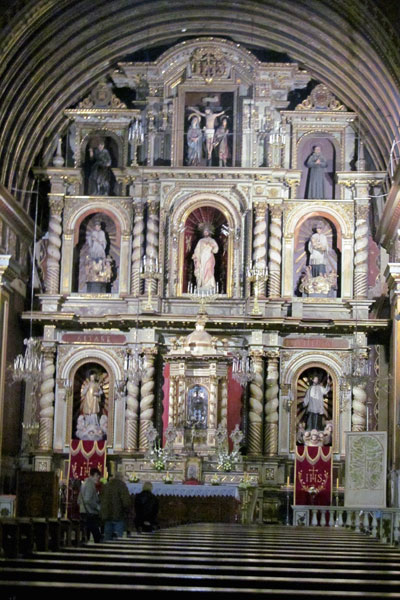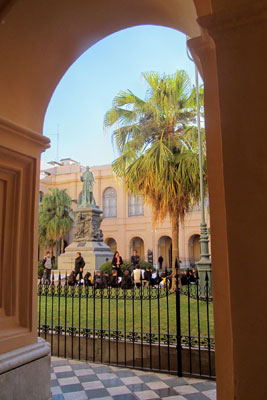Córdoba’s Manzana
Córdoba, Spain, is well known among travelers, famous as a UNESCO World Heritage Site and the home of sites dating from the days of its Moorish past (8th to 13th centuries). This is Old World Córdoba. Less well known to travelers is New World Córdoba, Argentina’s second-largest city (population 1.4 million).
Situated in the north-central part of the country, 420 miles northwest of Buenos Aires, Argentina’s Córdoba also has UNESCO World Heritage designated sites. These sights are linked to the city’s association with the Jesuits and, more recently, to Pope Francis, who was born in Buenos Aires as Jorge Mario Bergoglio and who lived in Córdoba in the 1990s.
Córdoba was founded in 1573 by Jerónimo Luis de Cabrera on land originally inhabited by a native American group called the Comechingones. Cabrera laid the city out in a checkerboard pattern of 70 parcels, or blocks, called manzanas. One of these blocks was allotted to the Jesuits who arrived in Córdoba in 1599.
Arrival of the Jesuits
The Jesuit order was founded in 1540 by Ignatius Loyola as part of the Counter Reformation in response to the rise of Protestantism. It was the Jesuit mission not only to convert but to teach.
In the New World, Córdoba became the heart of the order’s province, with settlements in what is now Argentina, Bolivia, Paraguay, Uruguay and Brazil. Within 14 years of their arrival in Córdoba, the Jesuits founded a seminary that became a university in 1622, the oldest in Argentina and one of the oldest in the Americas.
This Jesuit university was part of the Manzana Jesuítica, or Jesuit Block, that would also eventually include a chapel (1668), a church (1676) and a college (1687).
Manzana buildings
On our trip to Córdoba in August 2014, my husband, Paul, and I first visited the Jesuit Church, which has an austere, fortress-like exterior with two squat towers, a contrast to its ornate interior. The church boasts a unique ceiling that resembles the inverted hull of a ship plus an ornate, baroque-style gilded altarpiece.
Next door to the Jesuit Church is the university. Most of the faculties have moved elsewhere in the city, but the peaceful courtyard enclosed by arcades is open to visitors, as is the museum and library that now occupy most of the old university buildings. Don’t miss a look at the library’s 1645 Bible written in seven languages. (The courtyard, museum and library are open 10 to 12:30 and 2 to 4:30 Tuesday to Friday and 10 to 1 on Saturday.)
Adjacent to the university is the Collegium (College), which is now a prestigious secondary school, the National College of Montserrat, where classrooms surround a central courtyard. This school has been in use for over 325 years.
There’s also a chapel that’s part of the Manzana complex. Located behind the Jesuit Church, it was once the private church of the Jesuits. Although smaller than the Jesuit Church, it is just as ornate, with a barrel-vaulted ceiling, a painted dome and a gilded altarpiece with niches for statues and twisted Baroque columns.
Other places to visit
Although we had gone to Córdoba to visit the Manzana, we had the opportunity to stroll around the 400-year-old Plaza San Martin, with the 18th-century Cabildo (City Hall) and the 16th-century cathedral dominating one side. The cathedral is noteworthy for its dome painted on the inside by Emilio Caraffa, a Córdoban artist (1862-1939).
A few blocks away at 218 Rosario de Santa Fe is the Museo Provincial Marqués de Sobremonte, once the home of the Spanish governor of Córdoba, Marquis Rafael de Sobremonte y Nuñez.
Rooms filled with colonial-era furniture surround a series of lovely patios, one of which houses former slave quarters. This building, completed in 1760, is the largest colonial house to have survived intact in Argentina. (It’s open 9:30 to 2:30 Monday to Friday. Admission costs 15 pesos, about $2.)
There are several interesting museums to visit in Córdoba. Having time for only one, we chose the Museo Superior de Bellas Artes Evita, displaying Argentinian paintings and sculpture in an elegant mansion, the Palacio Ferreyra. (Located at 511 Avenida Hipólito Yrigoyen, it’s open 12 to 8 Tuesday to Sunday, and admission costs 15 pesos.)
If you go…
We stayed in the Azur Real (phone/fax 011 54 351 424 7133, www.azurrealhotel.com), an elegant boutique hotel located at 243 San Jerónimo, a 15-minute walk from the Manzana Jesuítica.
The Azur Real is modern, very “hip,” with a wonderful rooftop terrace. Our room was a split level just off the terrace. There’s an excellent restaurant on site. Meals are also served in the living room-style hotel reception area.
Room rates range from $160 to $229 per night, including tax and buffet breakfast.
Although it is possible to make a quick overnight trip from Buenos Aires to visit the Manzana Jesuítica, we don’t recommend it. Better to spend two or three nights to allow time to visit some of the estancias (ranches) also associated with the Jesuits.
There are frequent daily flights on Aerolineas Argentinas between Buenos Aires and Córdoba. Flights average one hour, 15 minutes, and you can fly from Jorge Newbery, Buenos Aires’ in-town airport, which is just a 10- to 15-minute cab ride from the Palermo and Recoleta sections of Buenos Aires.
You can tour the Manzana Jesuítica on your own, but a better idea is to hire a knowledgeable guide for a 2-hour tour, in English, of the Jesuit complex of buildings. The Azur Real Hotel Boutique arranged for Ariel Eduardo Bustos to meet us at the hotel and escort us to the Manzana Jesuítica.
Sr. Bustos can also be contacted by phone (011 54 9 351 223 6555) or by e-mail (info@pataperreando.com.ar). His fee for a 2-hour tour was 300 pesos, or about $37, at the time of our visit.



